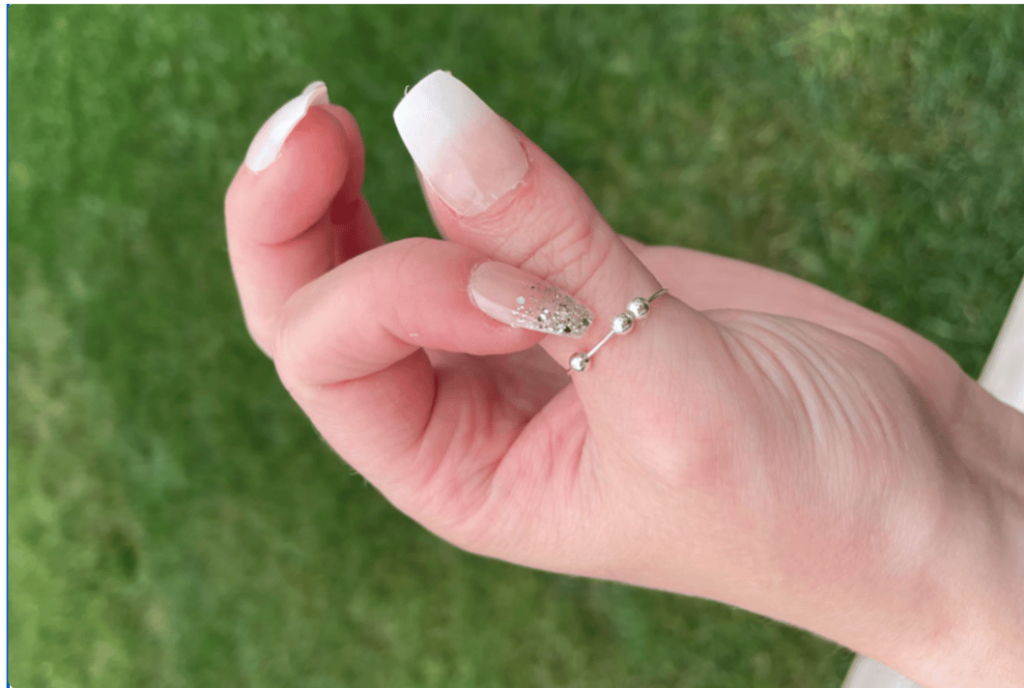In today’s fast-paced and stressful world, individuals are increasingly seeking ways to manage anxiety and stress. One such innovation that has gained popularity in recent years is the anxiety ring. These rings are designed not only for adornment but also to serve as a tool to help alleviate symptoms of anxiety and stress. In this blog, we’ll delve into what anxiety rings are, explore their advantages and disadvantages, and provide insights into whether they may be a beneficial addition to your daily life.
What Are Anxiety Rings?

Anxiety rings, also known as fidget rings or spinner rings, are a type of jewelry that incorporates elements for tactile stimulation. They typically consist of two or more bands—one or more of which can rotate or spin around the central band. This spinning or rotating motion provides a form of sensory engagement that can be soothing and calming.
Anxiety rings come in various styles, materials, and designs. Some are simple and elegant, while others are more elaborate, incorporating gemstones, intricate patterns, or engravings. Regardless of their appearance, the primary function of an anxiety ring is to provide an outlet for nervous energy or restlessness.
Advantages of Anxiety Rings
1. Stress Reduction
One of the primary advantages of anxiety rings is their ability to reduce stress and anxiety. The rhythmic motion of spinning or fidgeting with the ring can have a calming effect on the nervous system. This can be particularly helpful in situations where stress or anxiety levels are high, such as during meetings or exams.
2. Improved Concentration
For individuals who struggle with focus or attention, anxiety rings can serve as a useful tool. Fidgeting with the ring can help improve concentration and prevent distractions, making them beneficial for students and professionals alike.
3. Non-Disruptive
Unlike some fidget tools that may produce noise or distractions, anxiety rings are often silent and unobtrusive. This makes them suitable for use in quiet environments, such as libraries or during conversations.
4. Portable and Convenient
Anxiety rings are small and lightweight, making them easy to carry in your pocket or wear on your finger. They are readily available when you need them, providing an accessible way to manage anxiety throughout the day.
5. Stylish Accessories
Many anxiety rings are designed to be fashionable and stylish, making them versatile accessories that can complement your wardrobe. They blend seamlessly into your daily life, allowing you to wear them without drawing undue attention.
Disadvantages of Anxiety Rings
While anxiety rings offer several advantages, they also come with some potential drawbacks to consider:
1. Distraction
In some cases, fidgeting with an anxiety ring can become a distraction itself, especially if it leads to constant, compulsive spinning. This can interfere with tasks or conversations, rather than aiding concentration.
2. Not a Substitute for Professional Help
Anxiety rings are not a replacement for professional treatment for anxiety disorders or related conditions. While they can provide temporary relief, they are not a comprehensive solution for managing severe or chronic anxiety.
3. Risk of Damage or Loss
The rotating parts of anxiety rings are vulnerable to wear and tear over time. Additionally, there is a risk of the ring being lost or damaged if not handled with care. High-quality materials and craftsmanship can mitigate this risk.
4. Limited Scientific Evidence
While anecdotal evidence and personal testimonials suggest that anxiety rings can be effective, there is limited scientific research to support their therapeutic benefits. More studies are needed to determine their efficacy conclusively.
Should You Consider an Anxiety Ring?

Whether or not an anxiety ring is suitable for you depends on your individual needs and preferences. Here are some factors to consider:
- Severity of Anxiety: Anxiety rings may be more suitable for individuals experiencing mild to moderate anxiety or stress. If you have a diagnosed anxiety disorder, consult with a mental health professional for appropriate treatment options.
- Personal Preference: Some people find the tactile stimulation of anxiety rings soothing and enjoyable, while others may not benefit from them or may prefer alternative stress management techniques.
- Situational Use: Consider when and where you plan to use the ring. It may be more appropriate in certain settings, such as work or school, than in others.
- Budget: Anxiety rings come in various price ranges. Choose one that fits your budget and meets your style preferences.
Conclusion
Anxiety rings, with their unique design and tactile benefits, offer a potential means of managing stress and anxiety for some individuals. They can serve as discreet and stylish accessories that provide comfort during challenging moments. However, it’s essential to recognize their limitations and not rely on them as the sole solution for severe anxiety or related conditions. If you believe you may benefit from an anxiety ring, consider giving one a try and evaluating its impact on your overall well-being. Remember that seeking professional guidance and support for anxiety management is always advisable for more significant and persistent concerns.

I was more than happy to find this great site. I want to to thank you for ones time for this particularly fantastic read!! I definitely savored every little bit of it and i also have you bookmarked to see new things on your web site.